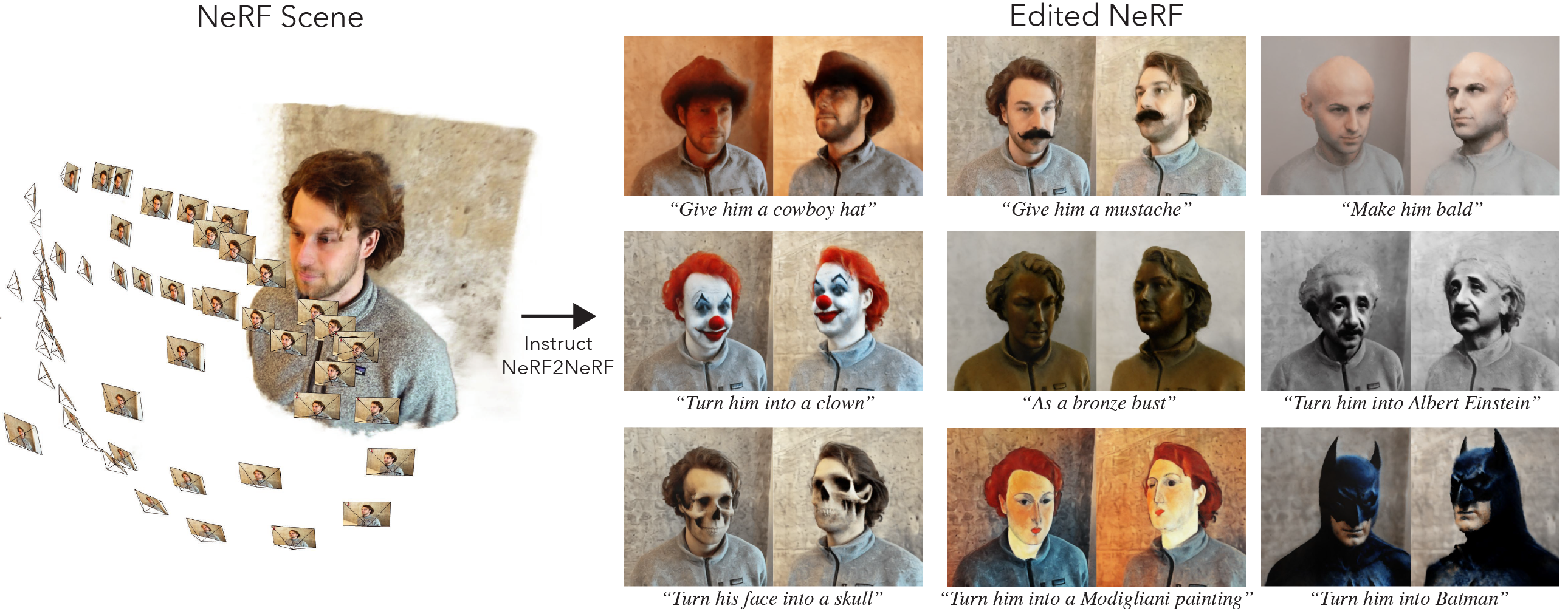This is the official implementation of Instruct-NeRF2NeRF.
Instruct-NeRF2NeRF is build on Nerfstudio and therefore has the same dependency reqirements. Specfically PyTorch and tinycudann are required.
Follow the instructions at this link to create the environment and install dependencies. Only follow the commands up to tinycudann. After the dependencies have been installed, return here.
Once you have finished installing dependencies, you can install Instruct-NeRF2NeRF using the following command:
pip install git+https://github.com/ayaanzhaque/instruct-nerf2nerfOptional: If you would like to work with the code directly, clone then install the repo:
git clone https://github.com/ayaanzhaque/instruct-nerf2nerf.git
cd instruct-nerf2nerf
pip install --upgrade pip setuptools
pip install -e .The following command should include in2n as one of the options:
ns-train -hTo edit a NeRF, you must first train a regular nerfacto scene using your data. To process your custom data, please refer to this documentation.
Once you have your custom data, you can train your initial NeRF with the following command:
ns-train nerfacto --data {PROCESSED_DATA_DIR}For more details on training a NeRF, see Nerfstudio documentation.
Once you have fully trained your scene, the checkpoints will be saved to the outputs directory. Copy the path to the nerfstudio_models folder.
To start training for editing the NeRF, run the following command:
ns-train in2n --data {PROCESSED_DATA_DIR} --load-dir {outputs/.../nerfstudio_models} --pipeline.prompt {"prompt"} --pipeline.guidance-scale 7.5 --pipeline.image-guidance-scale 1.5The {PROCESSED_DATA_DIR} must be the same path as used in training the original NeRF. Using the CLI commands, you can choose the prompt and the guidance scales used for InstructPix2Pix.
After the NeRF is trained, you can render the NeRF using the standard Nerfstudio workflow, found here.
Our method uses ~16K rays and LPIPS, but not all GPUs have enough memory to run this configuration. As a result, we have provided two alternative configurations which use less memory, but be aware that these configurations lead to decreased performance. The differences are the precision used for IntructPix2Pix and whether LPIPS is used (which requires 4x more rays). The details of each config is provided in the table below.
| Method | Description | Memory | Quality |
|---|---|---|---|
in2n |
Full model, used in paper | ~15GB | Best |
in2n-small |
Half precision model | ~12GB | Good |
in2n-tiny |
Half precision with no LPIPS | ~10GB | Ok |
Please note that training the NeRF on images with resolution larger than 512 will likely cause InstructPix2Pix to throw OOM errors. You can either downscale your dataset yourself and update your transforms.json file (scale down w, h, fl_x, fl_y, cx, cy), or you can use a smaller image scale provided by Nerfstudio. You can add nerfstudio-data --downscale-factor {2,4,6,8} to the end of your ns-train commands.
We recommend capturing data using images from Polycam, as smaller datasets work better and faster with our method.
If you have multiple GPUs, training can be sped up by placing InstructPix2Pix on a separate GPU. To do so, add --pipeline.ip2p-device cuda:{device-number} to your training command.
Please open Github issues for any installation/usage problems you run into. We've tried to support as broad a range of GPUs as possible, but it might be necessary to provide even more low-footprint versions. Please contribute with any changes to improve memory usage!
To build off Instruct-NeRF2NeRF, we provide explanations of the core code components.
in2n_datamanager.py: This file is almost identical to the base_datamanager.py in Nerfstudio. The main difference is that the entire dataset tensor is pre-computed in the setup_train method as opposed to being sampled in the next_train method each time.
in2n_pipeline.py: This file builds on the pipeline module in Nerfstudio. The get_train_loss_dict method samples images and places edited images back into the dataset.
ip2p.py: This file houses the InstructPix2Pix model (using the diffusers implementation). The edit_image method is where an image is denoised using the diffusion model, and a variety of helper methods are contained in this file as well.
in2n.py: We overwrite the get_loss_dict method to use LPIPs loss and L1Loss.
You can find our paper on arXiv.
If you find this code or find the paper useful for your research, please consider citing:
@article{instructnerf2023,
author = {Haque, Ayaan and Tancik, Matthew and Efros, Alexei and Holynski, Aleksander and Kanazawa, Angjoo},
title = {Instruct-NeRF2NeRF: Editing 3D Scenes with Instructions},
booktitle = {arXiv preprint 2303.12789},
year = {2023},
}

